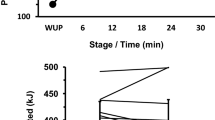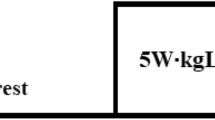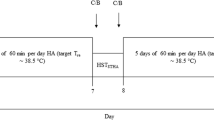Abstract
Purpose
Core temperature (Tc) shows rising (05:00–17:00 h) and falling (17:00–05:00 h) phases. This study examined the time-of-day effects on endurance exercise capacity and heat-loss responses to control Tc in the heat at around the midpoint of the rising and falling phases of Tc.
Methods
Ten male participants completed cycling exercise at 70% peak oxygen uptake until exhaustion in the heat (30 °C, 50% relative humidity). Participants commenced exercise in the late morning at 10:00 h (AM) or evening at 21:00 h (PM).
Results
Time to exhaustion was 28 ± 13% (mean ± SD) longer in PM (49.1 ± 16.3 min) than AM (38.7 ± 14.6 min; P < 0.001). Tc before and during exercise were higher in PM than AM (both P < 0.01) in accordance with the diurnal variation of Tc. The rates of rise in Tc, mean skin temperature, thermal sensation and rating of perceived exertion during exercise were slower in PM than AM (all P < 0.05). Dry and evaporative heat losses and skin blood flow during exercise were greater in PM than AM (all P < 0.05). During 30-min post-exercise recovery, the rates of fall in Tc and skin blood flow were faster and thermal sensation was lower in PM than AM (all P < 0.05).
Conclusions
This study indicates that endurance exercise capacity is greater and heat-loss responses to control Tc during and following exercise in the heat are more effective in the late evening than morning. Moreover, perceived fatigue during exercise and thermal perception during and following exercise are lower in the late evening than morning.




Similar content being viewed by others
Abbreviations
- HR:
-
Heart rate
- RPE:
-
Rating of perceived exertion
- SkBF:
-
Skin blood flow
- Ta :
-
Ambient temperature
- Tc :
-
Core temperature
- Tre :
-
Rectal temperature
- Tsk :
-
Mean skin temperature
- VO2peak:
-
Peak oxygen uptake
References
Adams WC, Mack GW, Langhans GW, Nadel ER (1992) Effects of varied air velocity on sweating and evaporative rates during exercise. J Appl Physiol 73:2668–2674
Aldemir H, Atkinson G, Cable T, Edwards B, Waterhouse J, Reilly T (2000) A comparison of the immediate effects of moderate exercise in the early morning and late afternoon on core temperature and cutaneous thermoregulatory mechanisms. Chronobiol Int 17:197–207
Aoki K, Shiojiri T, Shibasaki M, Takano S, Kondo N, Iwata A (1995) The effect of diurnal variation on the regional differences in sweating and skin blood flow during exercise. Eur J Appl Physiol Occup Physiol 71:276–280
Aschoff J, Heise A (1972) Thermal conductance in man: its dependence on time of day and on ambient temperature. In: Itoh S, Ogata K, Yoshimura H (eds) Advances in climatic physiology. Igaku Shoin, Tokyo, pp 334–348
ASHRAE (2005) Fundamentals volume of the ASHRAE handbook. ASHRAE, Atlanta
Atkinson G, Todd C, Reilly T, Waterhouse J (2005) Diurnal variation in cycling performance: influence of warm-up. J Sports Sci 23:321–329. https://doi.org/10.1080/02640410410001729919
Bardis K, Atkinson G (2008) Effects of time of day on power output and thermoregulation responses during cycling. J Biol Exerc 4:17–28
Borg GA (1982) Psychophysical bases of perceived exertion. Med Sci Sports Exerc 14:377–381
Cheuvront SN, Kenefick RW, Montain SJ, Sawka MN (2010) Mechanisms of aerobic performance impairment with heat stress and dehydration. J Appl Physiol 109:1989–1995. https://doi.org/10.1152/japplphysiol.00367.2010
Cohen J (1988) Statistical power analysis for the behavioral sciences, 2nd edn. Lawrence Erlbaum Associates, Hillsdale
Crewe H, Tucker R, Noakes TD (2008) The rate of increase in rating of perceived exertion predicts the duration of exercise to fatigue at a fixed power output in different environmental conditions. Eur J Appl Physiol 103:569–577. https://doi.org/10.1007/s00421-008-0741-7
Deschenes MR, Sharma JV, Brittingham KT, Casa DJ, Armstrong LE, Maresh CM (1998) Chronobiological effects on exercise performance and selected physiological responses. Eur J Appl Physiol Occup Physiol 77:249–256
Faulkner SH, Broekhuijzen I, Raccuglia M, Hupperets M, Hodder SG, Havenith G (2019) The threshold ambient temperature for the use of precooling to improve cycling time-trial performance. Int J Sports Physiol Perform 14:323–330. https://doi.org/10.1123/ijspp.2018-0310
Galloway SDR, Maughan RJ (1997) Effects of ambient temperature on the capacity to perform prolonged cycle exercise in man. Med Sci Sports Exerc 29:1240–1249
Gonzalez-Alonso J, Teller C, Andersen SL, Jensen FB, Hyldig T, Nielsen B (1999) Influence of body temperature on the development of fatigue during prolonged exercise in the heat. J Appl Physiol 86:1032–1039
Hobson RM, Clapp EL, Watson P, Maughan RJ (2009) Exercise capacity in the heat is greater in the morning than in the evening in man. Med Sci Sports Exerc 41:174–180. https://doi.org/10.1249/MSS.0b013e3181844e63
ISO (1995) Ergonomics of the thermal environment—assessment of the influence of the thermal environment using subjective judgement scales. ISO, ISO 10551, Geneva
Kenny GP, Reardon FD, Giesbrecht GG, Jetté M, Thoden JS (1997) The effect of ambient temperature and exercise intensity on post-exercise thermal homeostasis. Eur J Appl Physiol Occup Physiol 76:109–115
Kenny GP, Webb P, Ducharme MB, Reardon FD, Jay O (2008) Calorimetric measurement of postexercise net heat loss and residual body heat storage. Med Sci Sports Exerc 40:1629–1636. https://doi.org/10.1249/MSS.0b013e31817751cb
Maughan RJ, Otani H, Watson P (2012) Influence of relative humidity on prolonged exercise capacity in a warm environment. Eur J Appl Physiol 112:2313–2321. https://doi.org/10.1007/s00421-011-2206-7
Mora-Rodriguez R, Del Coso J, Hamouti N, Estevez E, Ortega JF (2010) Aerobically trained individuals have greater increases in rectal temperature than untrained ones during exercise in the heat at similar relative intensities. Eur J Appl Physiol 109:973–981. https://doi.org/10.1007/s00421-010-1436-4
Morrison S, Sleivert GG, Cheung SS (2004) Passive hyperthermia reduces voluntary activation and isometric force production. Eur J Appl Physiol 91:729–736. https://doi.org/10.1007/s00421-004-1063-z
Nielsen B (1996) Olympics in Atlanta: a fight against physics. Med Sci Sports Exerc 28:665–668
Nielsen B, Hales JR, Strange S, Christensen NJ, Warberg J, Salin B (1993) Human circulatory and thermoregulatory adaptations with heat acclimation and exercise in a hot, dry environment. J Physiol 460:467–485
Otani H, Goto T, Goto H, Shirato M (2017) Time-of-day effects of exposure to solar radiation on thermoregulation during outdoor exercise in the heat. Chronobiol Int 34:1224–1238. https://doi.org/10.1080/07420528.2017.1358735
Otani H, Kaya M, Tamaki A, Goto H, Maughan RJ (2019) Exposure to high solar radiation reduces self-regulated exercise intensity in the heat outdoors. Physiol Behav 199:191–199. https://doi.org/10.1016/j.physbeh.2018.11.029
Otani H, Kaya M, Tamaki A, Goto T, Goto H, Shirato M (2018a) Diurnal effects of prior heat stress exposure on sprint and endurance exercise capacity in the heat. Chronobiol Int 35:982–995. https://doi.org/10.1080/07420528.2018.1448855
Otani H, Kaya M, Tamaki A, Watson P, Maughan RJ (2018b) Air velocity influences thermoregulation and endurance exercise capacity in the heat. Appl Physiol Nutr Metab 43:131–138. https://doi.org/10.1139/apnm-2017-0448
Otani H, Kaya M, Tamaki A, Watson P, Maughan RJ (2016) Effects of solar radiation on endurance exercise capacity in a hot environment. Eur J Appl Physiol 116:769–779. https://doi.org/10.1007/s00421-016-3335-9
Parsons K (2014) Human thermal environments. Tayler & Francis, London
Ramanathan NL (1964) A new weighting system for mean surface temperature of the human body. J Appl Physiol 19:531–533
Reilly T, Baxter C (1983) Influence of time of day on reactions to cycling at a fixed high intensity. Br J Sports Med 17:128–130
Reilly T, Garrett R (1998) Investigation of diurnal variation in sustained exercise performance. Ergonomics 41:1085–1094
Roberts MF, Wenger CB, Stolwijk JA, Nadel ER (1977) Skin blood flow and sweating changes following exercise training and heat acclimation. J Appl Physiol 43:133–137
Sawka MN, Cheuvront SN, Kenefick RW (2012) High skin temperature and hypohydration impair aerobic performance. Exp Physiol 97:327–332. https://doi.org/10.1113/expphysiol.2011.061002
Schlader ZJ, Vargas NT (2019) Regulation of body temperature by autonomic and behavioral thermoeffectors. Exerc Sport Sci Rev 47:116–126. https://doi.org/10.1249/JES.0000000000000180
Stephenson LA, Wenger CB, O'Donovan BH, Nadel ER (1984) Circadian rhythm in sweating and cutaneous blood flow. Am J Physiol 246:R321–324
Thomas MM, Cheung SS, Elder GC, Sleivert GG (2006) Voluntary muscle activation is impaired by core temperature rather than local muscle temperature. J Appl Physiol 100:1361–1369. https://doi.org/10.1152/japplphysiol.00945.2005
Torii M, Nakayama H, Sasaki T (1995) Thermoregulation of exercising men in the morning rise and evening fall phases of internal temperature. Br J Sports Med 29:113–120
Waterhouse J, Aizawa S, Nevill A, Edwards B, Weinert D, Atkinson G, Reilly T (2007) Rectal temperature, distal sweat rate, and forearm blood flow following mild exercise at two phases of the circadian cycle. Chronobiol Int 24:63–85. https://doi.org/10.1080/07420520601142551
Waterhouse J, Drust B, Weinert D, Edwards B, Gregson W, Atkinson G, Kao S, Aizawa S, Reilly T (2005) The circadian rhythm of core temperature: origin and some implications for exercise performance. Chronobiol Int 22:207–225
Waterhouse J, Edwards B, Bedford P, Hughes A, Robinson K, Nevill A, Weinert D, Reilly T (2004) Thermoregulation during mild exercise at different circadian times. Chronobiol Int 21:253–275
Watson P, Hasegawa H, Roelands B, Piacentini MF, Looverie R, Meeusen R (2005) Acute dopamine/noradrenaline reuptake inhibition enhances exercise performance in warm, but not temperate conditions. J Physiol 565:873–883. https://doi.org/10.1113/jphysiol.2004.079202
Acknowledgements
The authors thank the participants who donated their time and effort to participate in the present study. The authors also thank Kyosuke Nakagawa and Kakeru Okazaki for assistance.
Funding
The present study was not supported by any specific grant.
Author information
Authors and Affiliations
Contributions
All authors were involved in the conception of the study. HO, MK and AT collected and analysed the data. All authors were involved in data interpretation, drafting of the manuscript, and approving the fnal version.
Corresponding author
Ethics declarations
Conflict of interest
All other authors declare no confict of interest in the development and completion of this study.
Ethical approval
All procedures performed in studies involving human participants were in accordance with the ethical standards of the Hyogo University of Health Sciences (REF: 18053) and have therefore been performed in accordance with the ethical standards laid down in the 1964 Declaration of Helsinki.
Informed consent
Participants were provided with written documentation of the possible risks and benefts related to their participation in this study and signed informed consent was obtained in writing.
Additional information
Communicated by George Havenith.
Publisher's Note
Springer Nature remains neutral with regard to jurisdictional claims in published maps and institutional affiliations.
Rights and permissions
About this article
Cite this article
Otani, H., Kaya, M., Goto, H. et al. Rising vs. falling phases of core temperature on endurance exercise capacity in the heat. Eur J Appl Physiol 120, 481–491 (2020). https://doi.org/10.1007/s00421-019-04292-6
Received:
Accepted:
Published:
Issue Date:
DOI: https://doi.org/10.1007/s00421-019-04292-6




